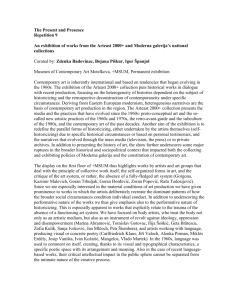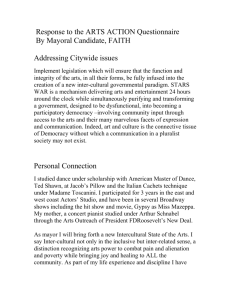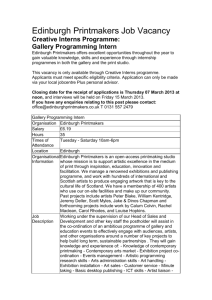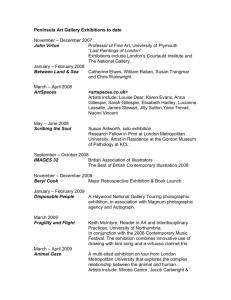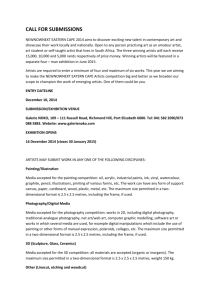Fragile Democracy - Northern Gallery for Contemporary Art
advertisement
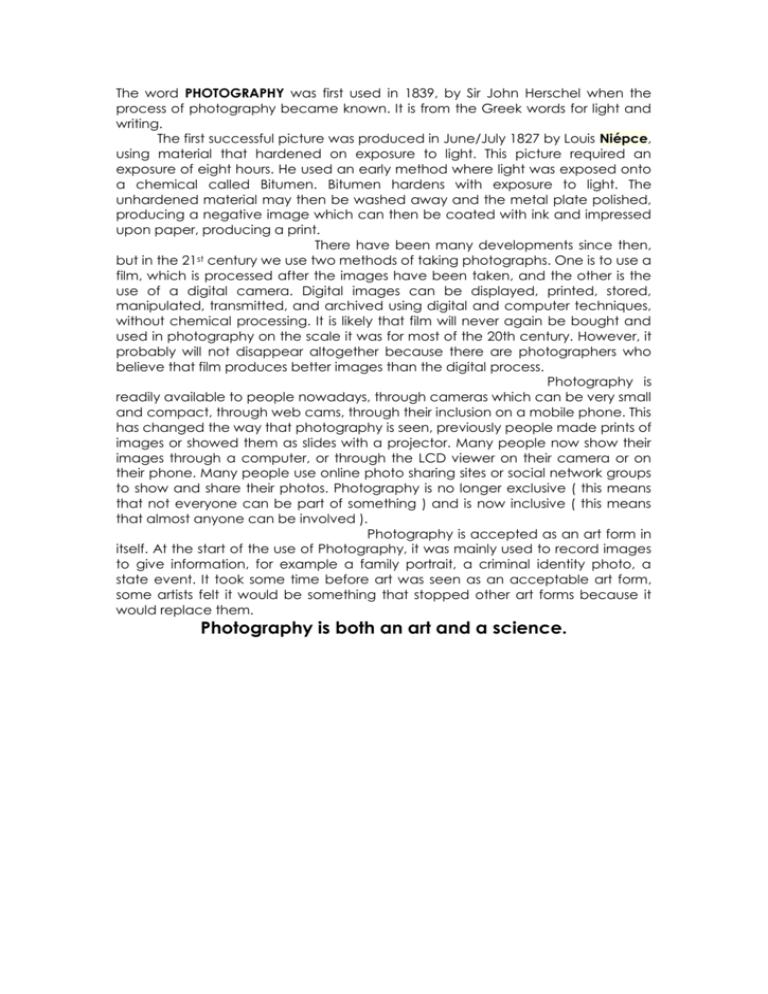
The word PHOTOGRAPHY was first used in 1839, by Sir John Herschel when the process of photography became known. It is from the Greek words for light and writing. The first successful picture was produced in June/July 1827 by Louis Niépce, using material that hardened on exposure to light. This picture required an exposure of eight hours. He used an early method where light was exposed onto a chemical called Bitumen. Bitumen hardens with exposure to light. The unhardened material may then be washed away and the metal plate polished, producing a negative image which can then be coated with ink and impressed upon paper, producing a print. There have been many developments since then, st but in the 21 century we use two methods of taking photographs. One is to use a film, which is processed after the images have been taken, and the other is the use of a digital camera. Digital images can be displayed, printed, stored, manipulated, transmitted, and archived using digital and computer techniques, without chemical processing. It is likely that film will never again be bought and used in photography on the scale it was for most of the 20th century. However, it probably will not disappear altogether because there are photographers who believe that film produces better images than the digital process. Photography is readily available to people nowadays, through cameras which can be very small and compact, through web cams, through their inclusion on a mobile phone. This has changed the way that photography is seen, previously people made prints of images or showed them as slides with a projector. Many people now show their images through a computer, or through the LCD viewer on their camera or on their phone. Many people use online photo sharing sites or social network groups to show and share their photos. Photography is no longer exclusive ( this means that not everyone can be part of something ) and is now inclusive ( this means that almost anyone can be involved ). Photography is accepted as an art form in itself. At the start of the use of Photography, it was mainly used to record images to give information, for example a family portrait, a criminal identity photo, a state event. It took some time before art was seen as an acceptable art form, some artists felt it would be something that stopped other art forms because it would replace them. Photography is both an art and a science. You are visiting the Northern Gallery for Contemporary Art. What is an art gallery ? An art gallery is a space , it is where art is placed , this is so that people can experience it. They can experience it in many different ways. They might have to look at it, or hear it , or touch it. An art gallery can be in a building, or it can be outside, it can also be in a space that moves ( it could be in a purpose built bus ) , or it can be a virtual gallery on the internet. Some art galleries have a collection of art which belongs to them. They also lend it to other galleries. Some art galleries do not have a collection, artists come and use their space so that the exhibitions change all the time. Most contemporary art galleries change their exhibitions throughout the year. The Northern Gallery for Contemporary Art presents changing exhibitions of new work by artists from around the world, it brings new art to new audiences. When you visit the gallery, you become the audience. This gallery offers opportunities to new artists as well as more established artists to show their work. It gives you the chance to see art of today in a contemporary setting. Contemporary art means that the art belongs to the present day. It is very important that you have an open mind when you see contemporary art . This means that it is important that you are prepared for new experiences and new knowledge. Art is not always pretty to look at or to experience. Art is not always easy to understand, but it can be interesting. Working out what makes it interesting to you is the key to understanding contemporary art. “ Fragile Democracy “ At the NGCA, The exhibition you are going to see and experience is called “ Fragile Democracy “. It features the work of 6 artists, 5 of these artists are working today. The artists are: August Sander : ( 1876 -1954 ), a German photographer Immo Klink, a photographer, born in Germany but based in London NontsikeLelo Veleko, a South African photographer Salome Oggenfuss a photographer from new York in the U.S.A Cyprien Gaillard from Paris, who uses video George Osodi a photographer . ‘Fragile Democracy’ brings together a selection of photographers and artists from around the world who use the camera to document communities. They look at micro-societies and subcultures ( this means smaller groups who are sometimes outside of what we call the mainstream of society ). The countries they visit are in a state of economic and political changes. In the world of 2008, all countries are going through changes because of the way that the balance of power is changing. They use the camera to show us situations and people from many different parts of the world. The artists take us to places that we might never have the chance to go to ourselves. Their cameras allow us to see a wider picture of the world, instead of just the things we see in our day to day lives. All of the contemporary works have either been made especially for ‘Fragile Democracy’ or are shown here for the first time in the UK. This makes this a very special exhibition. Each artist/photographer has had to make choices about their work, where they wanted to be, what they wanted to record, how they wanted to show it to an audience ( remember that you are the audience when you visit the gallery spaces ). August Sander’s work fits in with this exhibition but these images were created a long time ago at the start of the twentieth century. “Man of the Twentieth Century" was Sander's big, lifelong photographic project to record and document the people of Westerwald, near Cologne in Germany. This is the area where he lived. He said that "We know that people are formed by the light and air, by their inherited traits, and their actions. We can tell from appearance the work someone does or does not do; we can read in his face whether he is happy or troubled," Sander photographed subjects from all walks of life and created a big collection of more than six hundred photographs of the German people. It is very interesting to see Sander’s work alongside the work of Nontsikelelo Veleko because they both photograph people as they are. Veleko works in Johannesburg and Cape Town in South Africa. This country has seen a lot of change in recent years, for the first time the people are able to express their own identity and these “ dandies “ are shown in their wonderful and colourful clothes with the background of the city behind them. These people have made their own clothes and style and are not “ slaves to fashion “ as many people are. They don’t need the designer labels because they are their own designers. Salome Oggenfus takes her images in the Deep South in America. She shows us the people outside of the America that we normally see. Often these people are from poorer places, such as those living in trailer(caravan) parks, they have a quieter life in many ways and we seem them at work, at rest and at play. They don’t live in the big American cities. These are not the images we would see in a tourist brochure view of America. George Osodi shows Nigeria ( Africa ) as it is now, a once poor country which has discovered the huge amounts of money that can be made with oil and is ripping apart the land to get at it. But, the ordinary people are still poor and Osodi shows us the contrast between them as they are and the background of the ever growing oil industry. The average Nigerian still survives on less than £1 a day, despite the country’s £10 billion rise in oil exports to the United States over the past five years. George is drawing our attention to the people who are suffering because of the oil, as they lose their lands etc. He also shows us that governments might make money but that the people may not benefit from this. Immo Klink has documented 11 independent communities and communes across Europe, which have established themselves as self-sustaining groups. This means that the groups have decided to live outside of the general rules of society, they have their own rules for the way that they create their little communities. They all have different reasons for choosing this way of life. Klink has travelled around the continent for 4 years to record these different ways of life. This is about their way of life and the buildings which they create to live in. Cyprien Gaillard uses a video camera to record moving images. This is shown in 3 different chapters ( like a book ). In Russia ( St Petersburg ) the artists shows us two gangs meeting up and fighting, the background is the bleak and ugly city built after the second world war, the buildings are functional and have no character or beauty. The gangs are like two tribes, gathering together to attack the other tribe. But in the second chapter set in Paris, we see a light show being projected onto a building and start to enjoy it before the unexpected happens. In the third chapter we see how people live in Kiev, also in Russia, it is very different from the way that we live. The title “ Fragile Democracy “ helps us to understand the theme of this exhibition. Fragile means something that can easily break or be damaged. Democracy means a place or organisation that has a set of beliefs and a set of rules which are called laws. Democracy also supports freedom of speech, equal rights and lets the people vote for their leaders. The country that we live in is a democracy. Democracy sometimes works well, but democracy sometimes doesn’t work for all of the people. This can be for a number of reasons, not all leaders are fair, not all people respect the rules, not everyone has the chance to take advantages of the democratic process. In many so called democratic countries the division between rich and poor is wide. In a democratic society we encourage people to have their own beliefs, to express themselves in the way that they live their lives but we also have sets of rules and laws. People who choose to live outside of the laws and rules are punished and have their freedom taken away from them through prison, through community service etc. People also choose to live in different ways, without breaking the rules though. Some people choose to wear clothing and have body decoration that we see as extreme but we also accept that they have a right to do this. Some people might choose to build a house which is very different to what we normally see but if they ask permission and get it, they have the right to do that as well. In a democracy we allow people to have the freedom to be what they want to be as long as they do not break the laws and the rules. “ Fragile Democracy “ is a title which suggests that some of the ideals of democracy are not always present, so the democracy could “break”. We have seen this recently in countries where people are no longer allowed to vote for leaders or where leaders “ fix “ elections so that it looks as though they have won when , in fact, they have not. The world is changing all the time, the balance of power is changing all the time, so in many ways, we do not have a stable world. China is now a country which has a big influence on the world, America is changing because of the threats made to it’s way of life by what they call Terrorist groups. Europe sees a bigger mix of people living and working together. The U.K. now has a very different mixed population who live and work together. Countries which have a lot of oil ,which is used for fuel and for petrol , hold power over other countries. Activity 1 Pair work Choose a partner to work with. Look at the work of August Sander and the work of Lolo Veleko. Discuss the work using the questions below and make some notes. How are the images similar ? ___________________________________________________________________________ ___________________________________________________________________________ ___________________________________________________________________________ ___________________________________________________________________________ ___________________________________________________________________________ ___________________________________________________________________________ ___________________________________________________________________________ How are the images different ? ___________________________________________________________________________ ___________________________________________________________________________ ___________________________________________________________________________ ___________________________________________________________________________ ___________________________________________________________________________ ___________________________________________________________________________ ___________________________________________________________________________ If you were to be photographed wearing the clothes that give you your own personal identity, what would you choose to wear ? Describe the items and the colours below. _______________________________________________________________________________ _______________________________________________________________________________ _______________________________________________________________________________ _______________________________________________________________________________ _______________________________________________________________________________ _______________________________________________________________________________ _______________________________________________________________________________ What would these say about you ? Activity 2 Individual work Look at the work of Salome Oggenfuss. Sketch one of the images, remember that a drawing can be quick, like a diagram, just to get a record of what you are looking at. You can use words as well. Write some key words here which describe this image that you have chosen ___________________________________________________________________________ ___________________________________________________________________________ ___________________________________________________________________________ Activity 2 Individual work When you think about America, what sort of images come into your head ? Mindmap them in the box below…. When you look at Salome Oggenfuss’s work, do any of these images appear in her work ? If they do, give examples: ___________________________________________________________________________ ___________________________________________________________________________ ___________________________________________________________________________ ___________________________________________________________________________ ___________________________________________________________________________ ___________________________________________________________________________ ___________________________________________________________________________ ___________________________________________________________________________ ___________________________________________________________________________ ___________________________________________________________________________ In Salome’s view of America, what are the different things that her photographs tell you about the country and the people ? ___________________________________________________________________________ ___________________________________________________________________________ ___________________________________________________________________________ ___________________________________________________________________________ ___________________________________________________________________________ ___________________________________________________________________________ ___________________________________________________________________________ ___________________________________________________________________________ ___________________________________________________________________________ ___________________________________________________________________________ ___________________________________________________________________________ ___________________________________________________________________________ Activity 3 Individual work There is a lot to see in this exhibition. Everyone has their own way of looking at art work. Usually we find something that really stands out for us personally. When you have looked at all the work, find a piece of work which really does have impact on you ( it might look nice, might fascinate you or entertain you, it might worry or disturb you, it might puzzle you or annoy you....) Sketch it in the box below. Artist/Photographer is : __________________________________________ Image is called : _________________________________________________ Date work produced : _______________________________________ Describe the image in the box below, use key words, you do not have to use sentences. Activity 3 Small group work In your group, decide on one of the artists in the exhibition that you would like to do a small presentation on. Do a group Mindmap on the work that you are looking at. Then, plan a short presentation which will be given to the rest of the class. Everyone in the group will take part in this in some way. When you do the presentation try and cover these points; Who is the artist ? What is their background ? Where are the images from ? Why did the group choose this artist ? What is the artist saying in the work ? What do the group find particularly interesting about the artist ? Ask your audience if they have any questions to ask you. In my group were: ___________________________________________________________________________ ___________________________________________________________________________ ___________________________________________________________________________ We chose the work of : _____________________________________ Our group mindmap Group presentation: Notes and Plan

